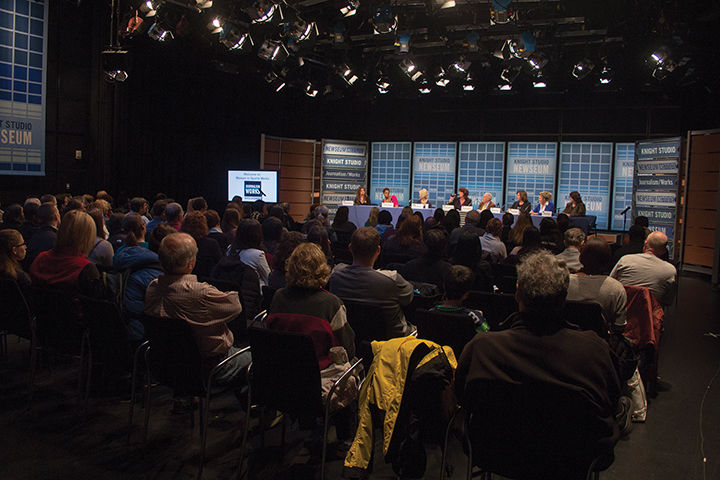
The Women in Sports Media Povich Panel discussed the field of sports journalism and what being a woman in that field was like. The panel was hosted in Knight Studio at the Newseum on Saturday Dec. 6, 2014.
On June 23, 1986, sports writer Susan Fornoff received a box from Oakland A’s player Dave Kingman while covering a game from the press box. It was a rat, with a label reading, “My name is Sue.”
And this past Thursday, a security guard denied Rachel Nichols, a reporter for CNN and Turner Sports, access to a reporting area under the assumption that she was an anthem singer rather than a journalist.
“I have gotten that at least a half dozen times, as well as, ‘The players’ wives aren’t allowed back here’ and things like that,” Nichols said.
Nichols and five other female sports journalists — Monica McNutt, Andrea Kremer, Marcia Keegan, Lesley Visser and Mary Byrne — gathered in Knight Studio at the Newseum in Washington Saturday afternoon for the “Women in Sports Media” panel. They addressed the current state of women in sports journalism and how to keep moving forward.
In a packed room of about 160 audience members, George Solomon, the director of this university’s Shirley Povich Center for Sports Journalism, which hosted the new event; and Christine Brennan, USA Today sports columnist, mediated the one-hour discussion and subsequent half hour Q-and-A session.
“We had a great turnout, we had a great venue and we had great questions from the audience,” Solomon said after the event. “It was a terrific day.”
On the state of women in sports journalism, panelists agreed that opportunities for women have increased significantly, especially since the installment of Title IX in 1972.
“For Lesley, Christine and I, when we were your age, we did not exist,” Kremer, the chief correspondent for player and health safety for the NFL Network, said. “When we were your age and we would think about what we wanted to do with our lives, the idea of being a female journalist, not even just a sports journalist, didn’t exist. That’s how far we’ve come.”
However, Byrne, the USA Today sports managing editor, noted that the panel itself was evidence enough that there is still a long way to go.
“The state of women in sports media is summarized by the fact that this panel, which features very distinguished journalists, also has an adjective next to it that they are women journalists,” Byrne said as murmurs of agreement circulated in the studio.
Nichols also pointed out that a 2012 study revealed 88.3 percent of sports journalists are men. Panelists maintained that this “glass ceiling” was due to a lack of women in decision-making positions.
“[Everywhere] people are more comfortable with people who look and think and talk like themselves, and I find that very dangerous,” said Keegan, ESPN’s vice president of production. “The next generation is going to be a very diverse group, and we need diverse opinions at the decision-making table.”
To encourage aspiring journalists in the audience, the panelists and moderators offered support and advice throughout the event on how to succeed in the future.
McNutt, sports anchor and reporter for News Channel 8, reminded female audience members to embrace and be proud of their gender, rather than comparing themselves with their male counterparts.
“We want to be better journalists and not necessarily female journalists, but at the end of the day I am a woman, and I celebrate that,” McNutt said.
Kremer encouraged female sports journalists to move out of their comfort zones and reach higher, and Visser and Brennan also emphasized the ability to write as a key to success.
“People will say to me, ‘Didn’t you start out as a writer?’ and I always say, ‘No, I’m still a writer,’” said Visser, a CBS Sports reporter. “There is no higher element.”
Freshman journalism major Samantha Waldenberg, who considers all of the women on the panel her role models, said she had great takeaways from the event.
“One of the biggest takeaways is don’t let the current status of women in sports media hold you back from doing whatever you want,” Waldenberg said. “Taking the word ‘can’t’ out of my vocabulary … I can do whatever I want to do.”



